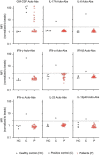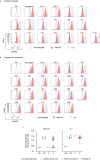Autoantibodies Neutralizing GM-CSF in HIV-Negative Colombian Patients Infected with Cryptococcus gattii and C. neoformans
- PMID: 39008214
- PMCID: PMC11249431
- DOI: 10.1007/s10875-024-01757-y
Autoantibodies Neutralizing GM-CSF in HIV-Negative Colombian Patients Infected with Cryptococcus gattii and C. neoformans
Abstract
Background: Cryptococcosis is a life-threatening disease caused by Cryptococcus neoformans or C. gattii. Neutralizing autoantibodies (auto-Abs) against granulocyte-macrophage colony-stimulating factor (GM-CSF) in otherwise healthy adults with cryptococcal meningitis have been described since 2013. We searched for neutralizing auto-Abs in sera collected from Colombian patients with non-HIV-associated cryptococcosis in a retrospective national cohort from 1997 to 2016.
Methods: We reviewed clinical and laboratory records and assessed the presence of neutralizing auto-Abs against GM-CSF in 30 HIV negative adults with cryptococcosis (13 caused by C. gattii and 17 caused by C. neoformans).
Results: We detected neutralizing auto-Abs against GM-CSF in the sera of 10 out of 13 (77%) patients infected with C. gattii and one out of 17 (6%) patients infected with C. neoformans.
Conclusions: We report eleven Colombian patients diagnosed with cryptococcosis who had auto-Abs that neutralize GM-CSF. Among these patients, ten were infected with C. gattii and only one with C. neoformans.
Keywords: Cryptococcus gattii; Cryptococcus neoformans; Anti-cytokine autoantibodies; Cryptococcosis; Granulocyte-macrophage colony-stimulating factor (GM-CSF); Human immunodeficiency virus (HIV), Neutralizing auto-abs against GM-CSF.
© 2024. The Author(s).
Conflict of interest statement
The authors declare no competing interests.
Figures


Update of
-
Autoantibodies neutralizing GM-CSF in HIV-negative Colombian patients infected with Cryptococcus gattii and C. neoformans.Res Sq [Preprint]. 2024 Jan 19:rs.3.rs-3873029. doi: 10.21203/rs.3.rs-3873029/v1. Res Sq. 2024. Update in: J Clin Immunol. 2024 Jul 15;44(7):163. doi: 10.1007/s10875-024-01757-y. PMID: 38313298 Free PMC article. Updated. Preprint.
References
Publication types
MeSH terms
Substances
Grants and funding
LinkOut - more resources
Full Text Sources

